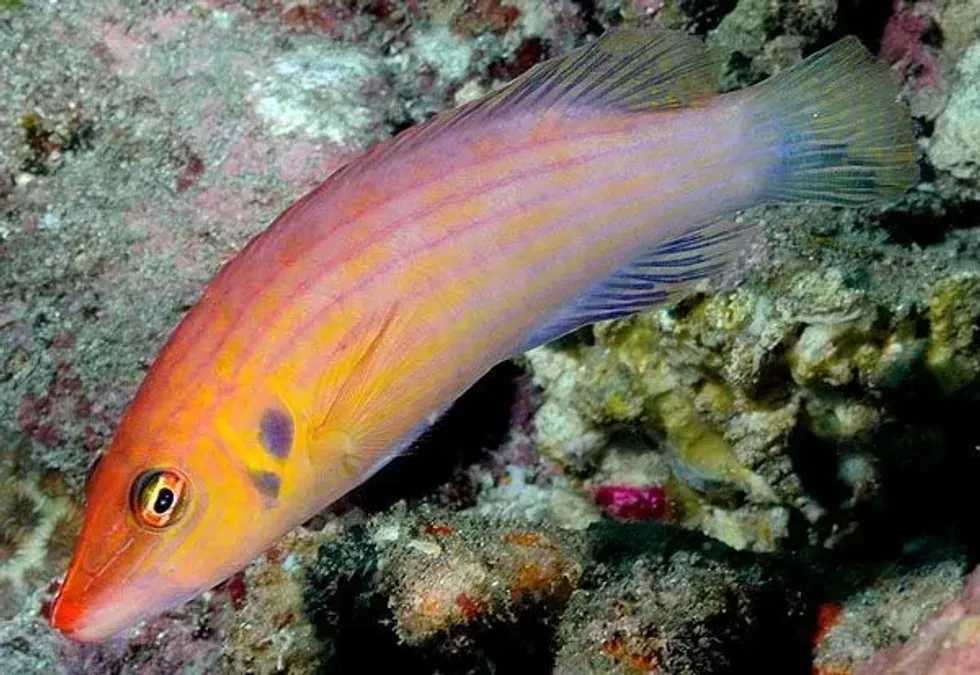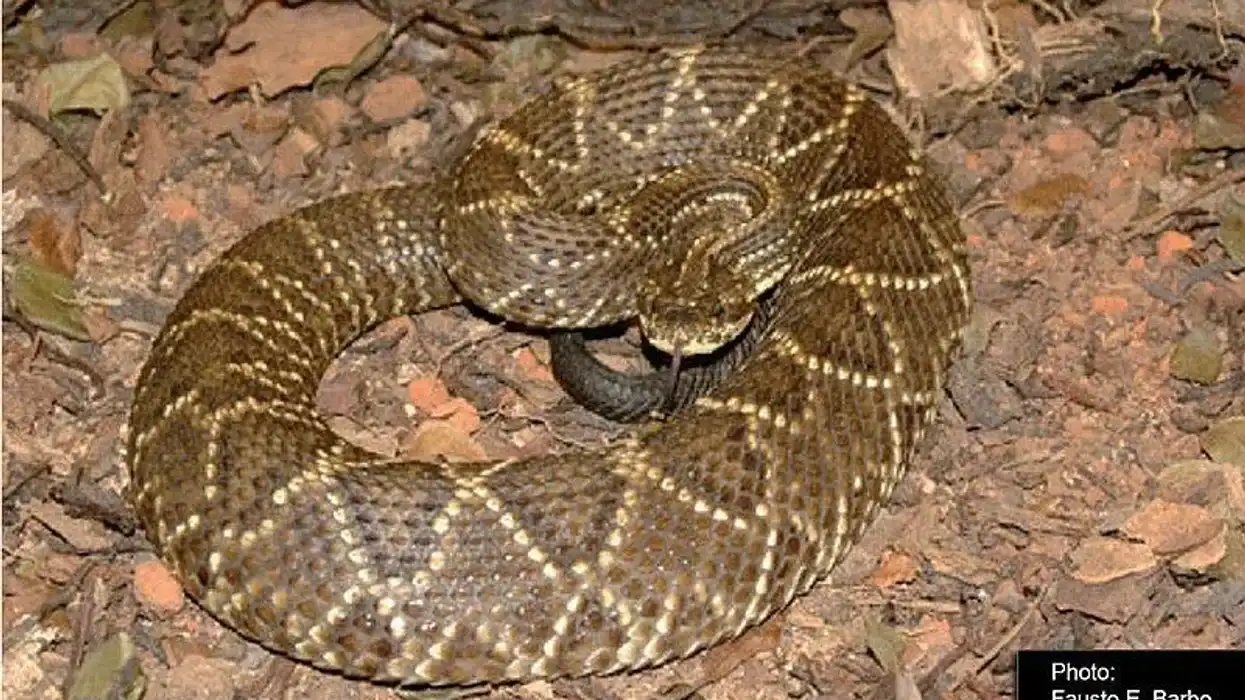Wrasse is a family of brightly colored marine fishes consisting of more than 600 species. One such wrasse called the eight-line wrasse (Pseudocheilinus octotaenia) is a type of marine fish found in the sea and ocean all over the world.
The fish is commonly known by several other alternate names like the eight-lined fairy wrasse, eightline wrasse, and eight stripe wrasse. It is named after the eight neon blue horizontal stripes carved on its striking orange body.
These reef safe fishes do not face any threats of extinction. The hardy and disease-resistant nature of the fish have succeeded in maintaining a stable population of the eight-line wrasses.
The vibrating colors and intricate designs on the tail and fins of the fish make the species a famous choice as aquarium fishes. The captive environment of the fish should imitate its natural environment.
Placing good-quality rocks and corals in an aquarium with plenty of hiding places provides an optimal ecosystem for the fish. The fish prefer staying with either semi-aggressive small fish species or large and nonaggressive species.
They cannot be kept with small crustaceans, crab, and shrimp. To know more facts about the eight-line wrasse, keep on reading these amazing facts.
For similar content, check out exquisite wrasse and flame wrasse facts too.
Eight-lined Wrasse Interesting Facts
What type of animal is an eight-lined wrasse?
An eight-lined wrasse (Pseudocheilinus octotaenia) is a type of fish.
What class of animal does an eight-lined wrasse belong to?
The eight-line wrasse (Pseudocheilinus octotaenia) of Labriformes order and Labridae family belong to the class Actinopterygii, the common class for all ray-finned bony fishes.
How many eight-lined wrasses are there in the world?
The global population of the eight-line wrasse has not been estimated yet. The fish inhabits seas all over the world and have an extremely large range.
There is no specific population information available for these wrasses. It is a fairly common fish and is found abundantly across their local range. They do not face any major threat in the wild as of yet.
Where does an eight-lined wrasse live?
The eight-line wrasse is distributed throughout the Indian Ocean and the Pacific Ocean. They are also available in the Red sea.
What is an eight-lined wrasse's habitat?
The eight-line wrasses is a marine fish distributed in several seas and oceans of the world. They are a shallow water species found at depths ranging from 6.5-164 ft (2-50 m).
It is a reef-safe fish that take shelter in the crevices and caves made up of invertebrates growth like live corals, reef, and rubble. In the night, the eight-line wrasse sleeps by making a mucus cocoon around its body. This cocoon is supposed to protect the fish from its nocturnal predators.
Who does eight-lined wrasse live with?
The eight-lined wrasse is generally a solitary species. They become aggressive towards their own species if they are kept together in the aquarium. In the wild, the fish do not form schools with other wrasse species because of their aggressive nature. In captivity, the fishes have some specific tank mates with whom they can live.
How long does an eight-lined wrasse live?
The lifespan of the eight-line wrasses is unknown. However, wrasses can live up to 30 years of age.
How do they reproduce?
In case of a shortage of male fish to breed, a female wrasse can transform its sex and play the role of the male. An elaborate description regarding the breeding methods of the eight-lined fish is missing.
They have not been in captivity, so their captive mating preferences are unknown. In the wild, the reproductive method of this marine species is highly unobserved. Since they are aggressive in nature, it is assumed that the fish do form long-lasting pairs; rather, females change their sexes for the purpose of spawning.
What is their conservation status?
The eight-line wrasse is classified as a species of Least Concern in the IUCN Red List. The fishes have an extremely large range and a stable population trend. Therefore, they do not reach the threshold of endangered species currently. The absence of major threats has also saved them from the hands of extinction.
Eight-lined Wrasse Fun Facts
What does eight-lined wrasse look like?
The eight-line wrasse is one of the largest lined wrasses that are commonly found around the world. Their physical description matches with the appearance of six lined and four-lined wrasses. It has a bright orange-red body with eight horizontal stripes.
The purplish-blue horizontal stripes run throughout their body from the mouth up to the tail. Few yellow spots are present on the cheeks and gill cover of the fish. Enlarged blotches are observed on the dorsal parts of its body.
 *Please note this is an image of a six-lined wrasse, not an eight-lined wrasse. If you have an image of an eight-lined wrasse, please let us know at hello@kidadl.com.
*Please note this is an image of a six-lined wrasse, not an eight-lined wrasse. If you have an image of an eight-lined wrasse, please let us know at hello@kidadl.com.
How cute are they?
The eight-line wrasse is one of the most beautiful wrasses. They look very cute.
How do they communicate?
This fish communicated by releasing chemical cues. No specific communication behavior has been noticed.
How big is an eight-lined wrasse?
An eight-line wrasse can reach a length up to 5.5 in (14 cm). They are larger than the rockmover wrasses.
How fast can an eight-lined wrasse swim?
The eight-line wrasse is a fast swimmer; however, their speed has not been determined.
How much does an eight-lined wrasse weigh?
The weight of an eight-lined wrasse is unknown.
What are the male and female names of the species?
A male and a female fish do not have any specific name.
What would you call a baby eight-lined wrasse?
An eight-line wrasse juvenile is called a fry.
What do they eat?
The eight line wrasse is carnivorous in nature; they eat protein reach foods. Some common foods of the species are Mysis shrimp. Apart from shrimp, they also feed on small crustaceans, crab, and eggs in the sea.
Are they poisonous?
No, they are not poisonous.
Would they make a good pet?
Yes, they make good aquarium fish.
Did you know...
The eight-lined wrasse is a hermaphroditic fish; it can change its sex once they mature.
Are eight-lined wrasse reefs safe?
Wrasses are found among marine corals and reef rubbles. They take shelter in the rocks and crevices of the coral reef. Therefore they are considered to be reef safe fishes.
Eight-lined wrasse tank mates?
The eight-line wrasse is an aggressive species that cannot coexist peacefully with other wrasse species. Therefore, it is better not to keep them with other wrasses.
In an aquarium, the eight-line wrasse can live with some semi-aggressive or less aggressive large fishes. Some preferred tank mates for the fish species are goatfish, puffer, angelfish, squirrelfish, and butterflyfish.
While choosing its tank mates, it is better to avoid small sea animals like sea urchins, crab, shrimp, and crustaceans as they act as their sources of different foods.
Here at Kidadl, we have carefully created lots of interesting family-friendly animal facts for everyone to discover! For more relatable content, check out these humphead wrasse and leopard wrasse.
You can even occupy yourself at home by drawing one on our fish coloring pages.




 *Please note this is an image of a six-lined wrasse, not an eight-lined wrasse. If you have an image of an eight-lined wrasse, please let us know at hello@kidadl.com.
*Please note this is an image of a six-lined wrasse, not an eight-lined wrasse. If you have an image of an eight-lined wrasse, please let us know at hello@kidadl.com.



